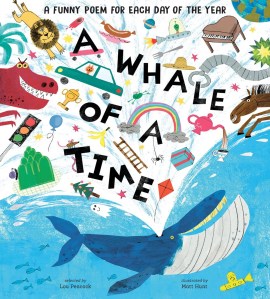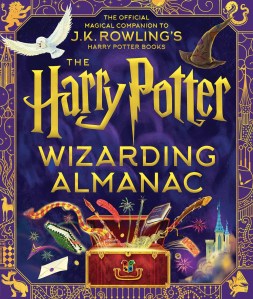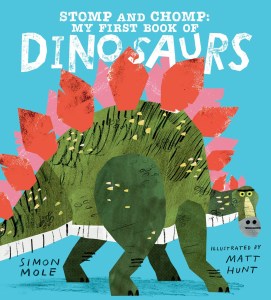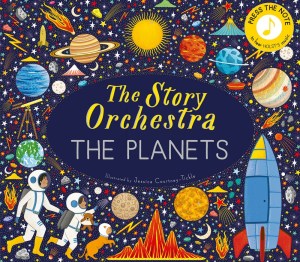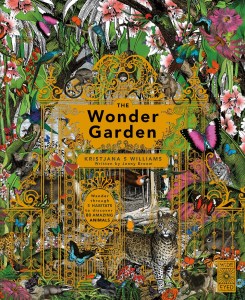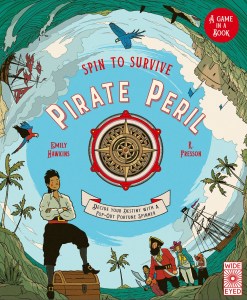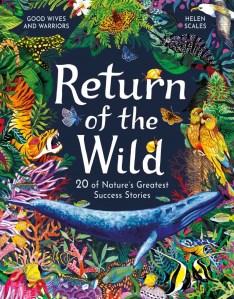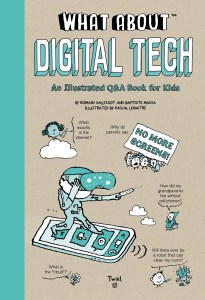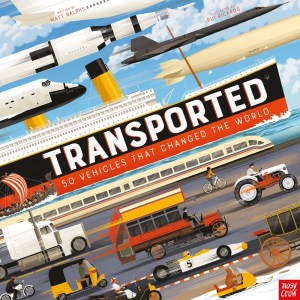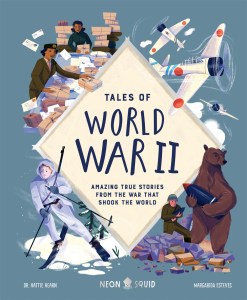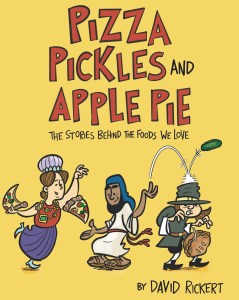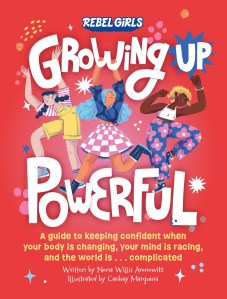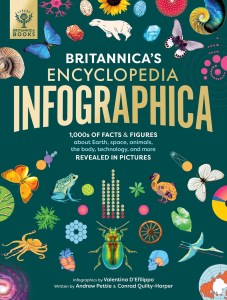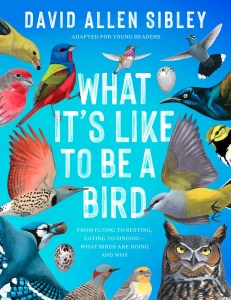2023 Gift Guide: Browsable Non-Fiction & Novelty Books for Ages 2-15
November 7, 2023 Comments Off on 2023 Gift Guide: Browsable Non-Fiction & Novelty Books for Ages 2-15

Houston, we have lift off! Welcome to the first installment of the 2023 Gift Guide. It may be a bit later in hitting your inboxes this year, but trust me when I tell you that the wait will have been worth it. I have never worked harder to find the giftiest books of the year—most of them published just in the past few weeks—and I can honestly say it’s the best Guide yet. In coming weeks, as fast as I can pen these posts, you’ll be getting SIX more installments: Picture Books, Illustrated Chapter Books, Middle Grade, Graphic Novels, Young Adult, and Board Books. Whew, that’s a lot of books!
Today is all about the Show Stoppers. These are the books with max gift appeal. The books that might feel, whether to an avid reader or one who’s more reluctant, a little different than the status quo. When I polled you on social media about what you wanted to see more of on this year’s Guide, the resounding answer was THESE KIND OF BOOKS. So yes, thanks to you, this section is now unwieldy and massive and totally awesome.
Some of these books are interactive. Some are browsable non-fiction that you can leave casually lying around the house for hours of turn-to-any-page, stumble-upon-new-knowledge entertainment. You’ll see new titles in favorite series from past Gift Guides, as well as a host of books that will feel completely new.
Let’s talk for a second about shopping. If you’re in the Northern Virginia area, I would love it if you’d consider buying your books from Old Town Books, where I work and where the entire Kids & Teen Guide is on display. If you live near another terrific indie, please support them! Indie bookstores are vital to book-loving communities and can only flourish with your support. (And hey, while I have you, snag tickets to my two upcoming in-person events here!)
Shall we begin? With the exception of the first two heavy hitters, titles are roughly arranged from youngest to oldest (suggested age ranges are listed in the headlines).
For the Whole Family
A Whale of a Time: Funny Poems for Each Day of the Year
selected by Lou Peacock; illus. Matt Hunt
Ages 4-adult
What would my Gift Guide be without the newest title in this fan-favorite, heaviest-gift-under-the-tree, perfect-for-kicking-off-a-new-year series?! (Past titles are Sing a Song of Seasons: A Nature Poem for Each Day of the Year and Tiger, Tiger Burning Bright: An Animal Poem for Each Day of the Year.)I love hearing about how so many of you have incorporated the reading of these poems into your everyday routine, whether at the breakfast or dinner table, as well as how much fun your kids have flipping through the anthologies to find the “birthday” poems for each member of the family. So, without further ago, I present this year’s A Whale of a Time: A Funny Poem for Each Day of the Year.
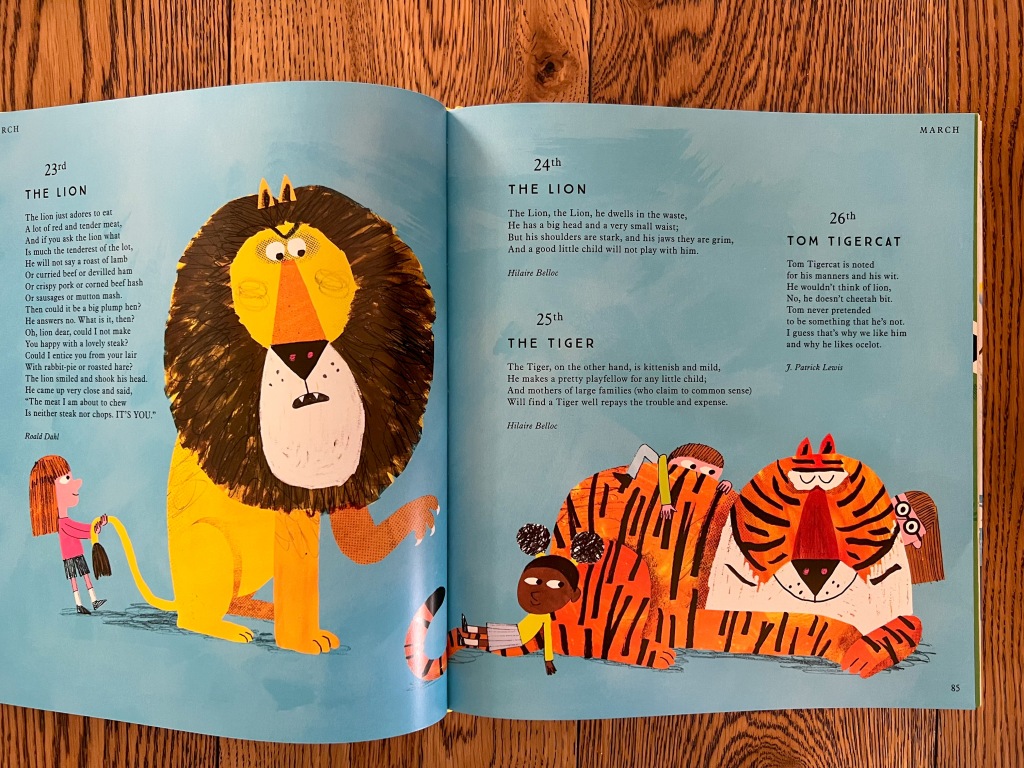
That’s right, this year’s theme is humor! These 366 silly poems, one for each day, hail from the likes of Maya Angelou, Gwendolyn Brooks, William Carlos Williams, T.S. Eliot, Shirley Hughes, Robert Louis Stevenson, that slippery fella “Anonymous,” and many more. From dinosaurs knocking loudly on door to worms wiggling on human tongues, from the musings of a poetic toad to the search for a word that rhymes with “orange,” these poems lend a welcome note of levity to every day, all the while exposing listeners to poetic form, word play, and some of the leading names in poetry. Plus, Matt Hunt’s illustrations are as much fun as the poems themselves!
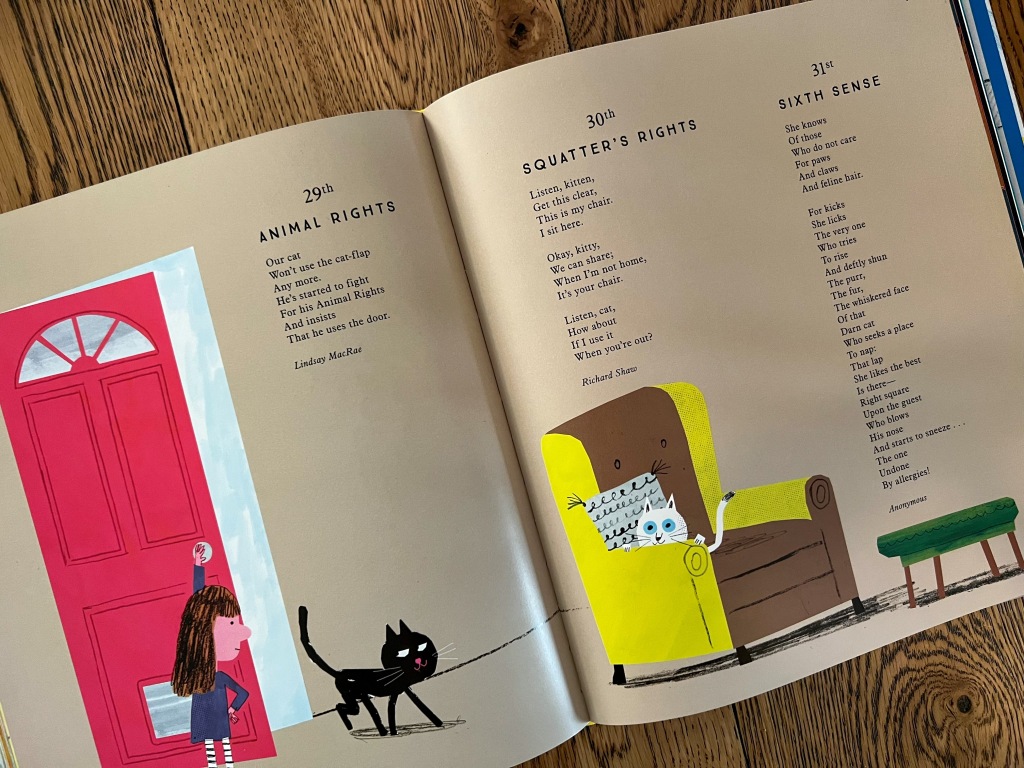
Hurry up, January 1, we’re eager to begin!
For the Potterhead
The Harry Potter Wizarding Almanac: The Official Companion to J.K. Rowling’s Harry Potter Books
illus. by Peter Goes, Louise Lockhart, Weitong Mai, Olia Muza, Pham Quang Phuc, Levi Pinfold, Tomislav Tomić
Ages 8-adult
Our family LOVES Harry Potter. The books, the experiences, the garb: we do it all. (Harry Potter LEGO advent calendar? We’ll take two, vomit-flavored jellybeans be darned.) Now, this holiday season, we are blessed with The Harry Potter Wizarding Almanac. Can it live up to the Harry Potter set tour we did in London this past summer? Yup. Does it delight the eyes as much as Universal’s butter beer delights our bellies? Yes, it does.
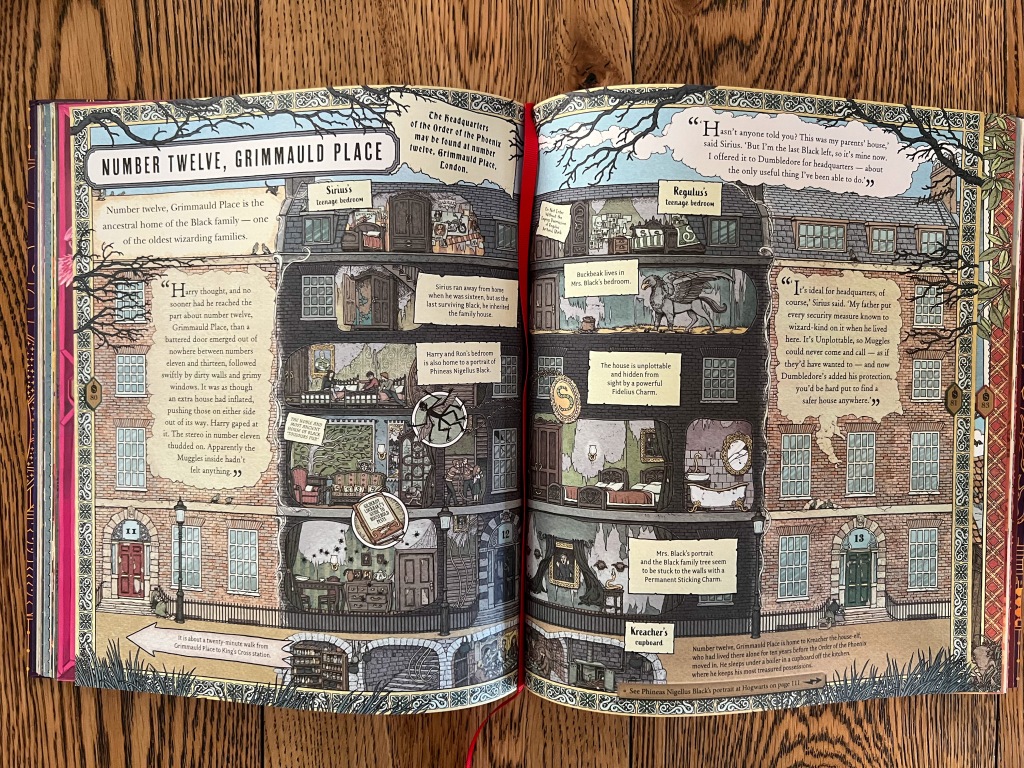
The product of seven different illustrators, each lending their own unique style and approach, this graphics-filled reference guide pulls together an encyclopedic history of the wizards, enchanted places, magical creatures, charms and curses, and backstories of all eight books, with a visual feast at every turn. It feels more like a flowing infographic than an almanac, and it’s near impossible to skim for the way it entices our eyes to hover and zoom in. There are layers of detail that will delight the biggest Potterheads, and the organization might actually trigger some memories or connect some dots for those who didn’t catch it all on the first several readings of the series.
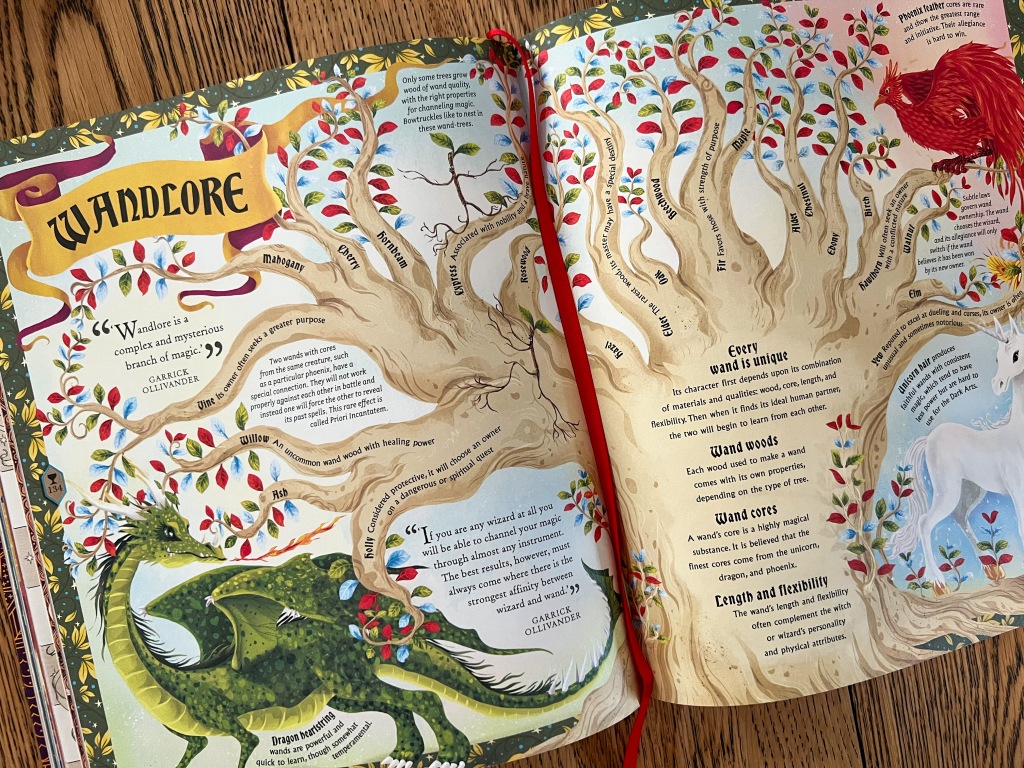
I picture our kids having this spread next to them on their bed as they re-read one of the books and turn to the page of incantations or magical house pets to bring a concept into clearer focus. For sure, this won’t be out for long before one of them squirrels it away.
For the Newly-Crowned Dino Enthusiast
Stomp and Chomp: My First Book of Dinosaurs
by Simon Mole; illus. Matt Hunt
Ages 2-5
What’s my three-year-old, dino-obsessed nephew getting from me this holiday? This 80-page oversized treasure trove of drolly-presented dinosaur details alongside colorful, mixed-media art, of course! (Psst, the art is by the same illustrator as the poetry book above!) Trust me, this one’s a gift for the parents as much as the kids, because it’s nothing like the dry fact-based dino books that’ll put us straight to sleep, even as our kids beg to hear more about their prehistoric obsessions. By contrast, Stomp and Chomp: My First Book of Dinosaurs, which sneaks facts into poems penned by an award-winning children’s poet, is a joy to read and behold.
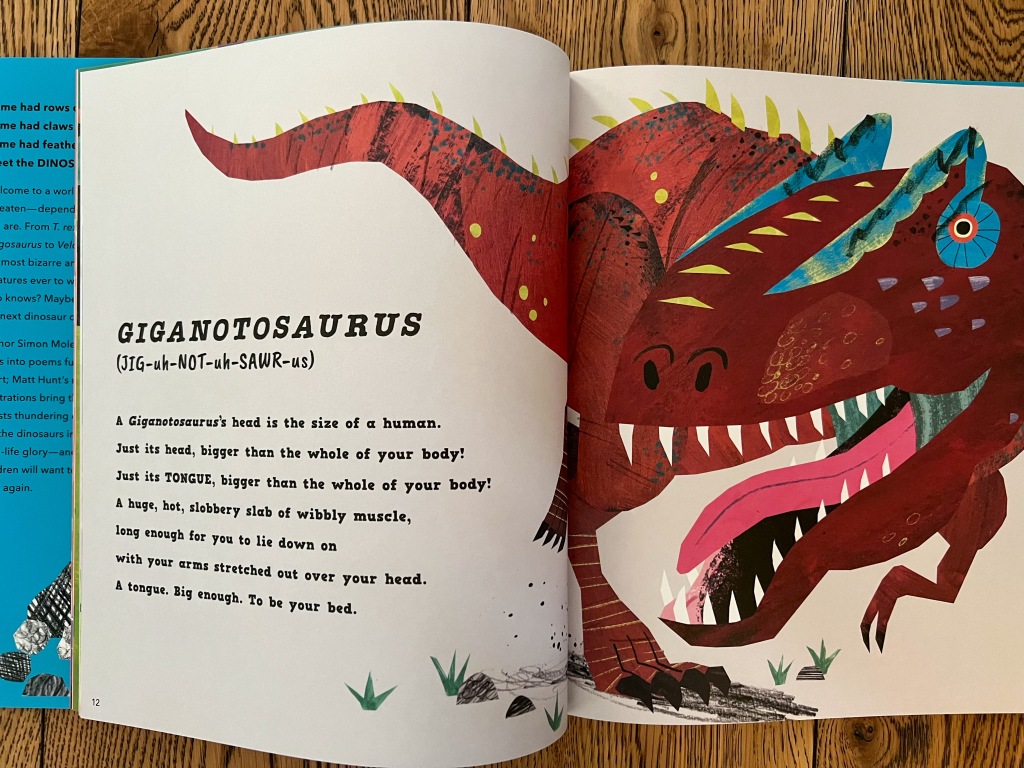
Did you know Giganotosaurus had a tongue big enough to be your bed? That one Brachiosaurus weighed the same as TEN THOUSAND cats? That Diplodocus was a “planet on legs,” its back home to a myriad of small animals? Thirty poems, divided into four fact-packed sections, put readers up close and personal with species from T. Rex to Triceratops, Stegosaurus to Velociraptor. Some have lines of terrible teeth, while others sport feathery peacock tails. All thunder off the page in vibrant illustrations pitched to poems that ring with humor and heart, while relaying well-researched facts about dinosaur anatomy, diet, herd behavior, and more. (Yes, even poop.)
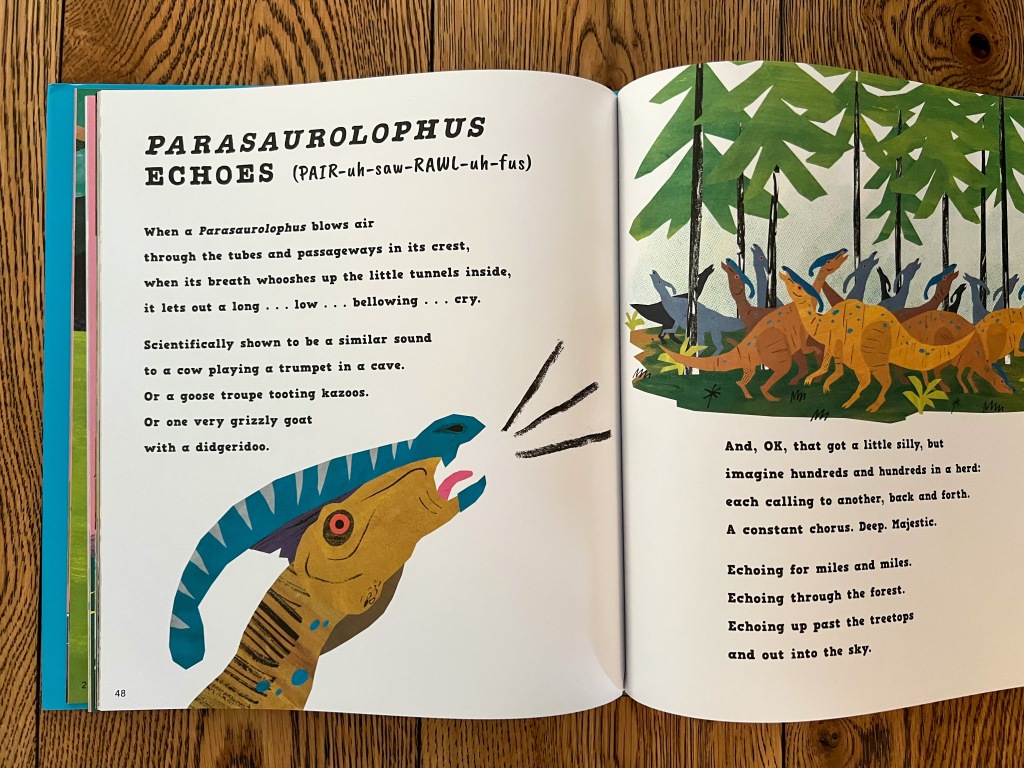
Back matter includes a time line and information about the Triassic, Jurassic, and Cretaceous periods.
For the Music Lover
The Story Orchestra: The Planets
illus. Jessica Courtney-Tickle
Ages 5-8
Last year’s Gift Guide boasted not one but two titles in the popular interactive series, The Story Orchestra. When I heard that this year’s title would pay homage to the celestial music of English composer, Gustav Holst, I wasn’t sure if it would have the same kid appeal. Then I got my hands on it, and The Story Orchestra: The Planets might be my favorite of the entire bunch! Combining music and STEM, with luminous artwork by Jessica Courtney-Tickle, this one feels as unique as they come.
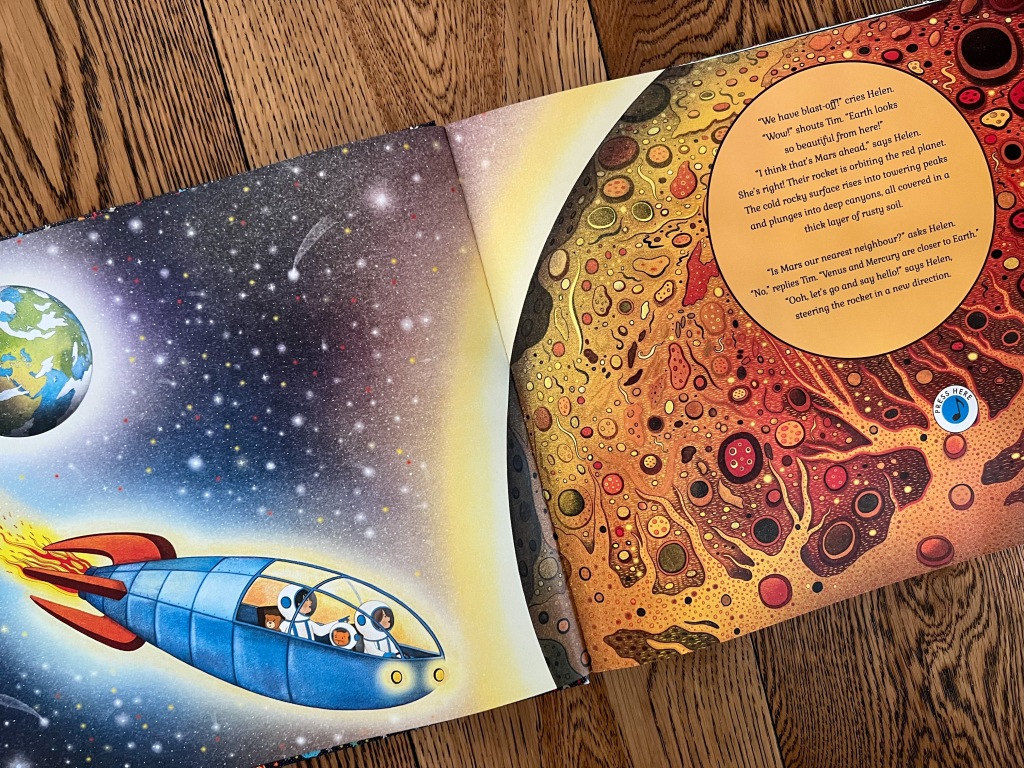
Tim and Helen are excited for their first night in their new space-themed bedroom, but little do they know that when the lights go out, the countdown to an interplanetary adventure begins. With a “flash of fiery light,” their bunk bed rockets them into space for a tour of all eight planets of our Solar System. At every step, readers can press a button to hear a different clip of Holst’s orchestral suite, “The Planets,” which grew out of his interest in astrology and was performed for the first time in 1918.

Backmatter introduces kids to Holst himself, as well as provides more details on each musical clip so kids can better discern the different instruments and sounds. A book that’s truly out of this world!
For the Baker (to Be)
David Atherton’s Baking Book for Kids
by David Atherton; illus. Harry Woodgate
Ages 5-9
Everyone’s favorite Great British Baking Show winner, David Atherton, guides readers through a delicious array of sweet and savory baked treats with easy-to-follow instructions. This is the first year the Gift Guide has included a kids cookbook, and that’s because David Atherton’s Baking Book for Kids is no ordinary cookbook. Children’s illustrator, Harry Woodgate—you know them from favorites like Grandad’s Camper—elevates Atherton’s recipes with infectious full-color artwork, giving this practical book the feel of a cherished picture book!
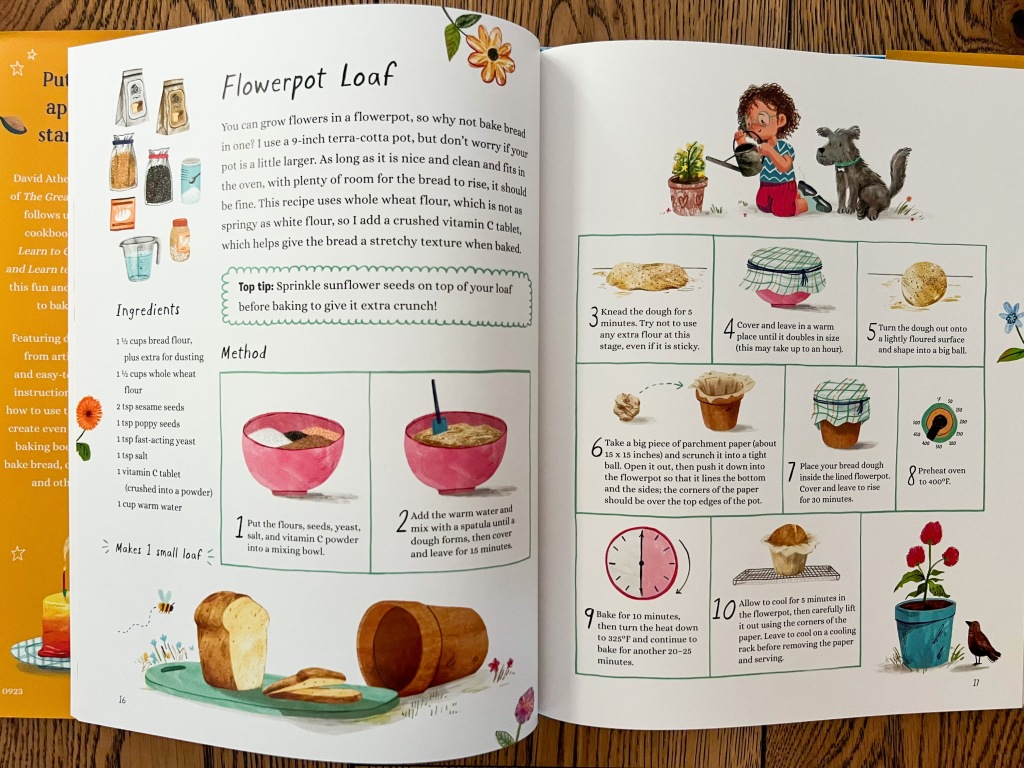
From snacky samosas to sausage roll flowers, cinnamon pretzel letters to a fancy ombre cake, these 34 mouth-watering recipes are guaranteed to inspire confidence in the kitchen by imparting a range of skills. The recipes are served up with clearly delineated, step-by-step instructions, each one paired with an illustration to make it easy on the eye.
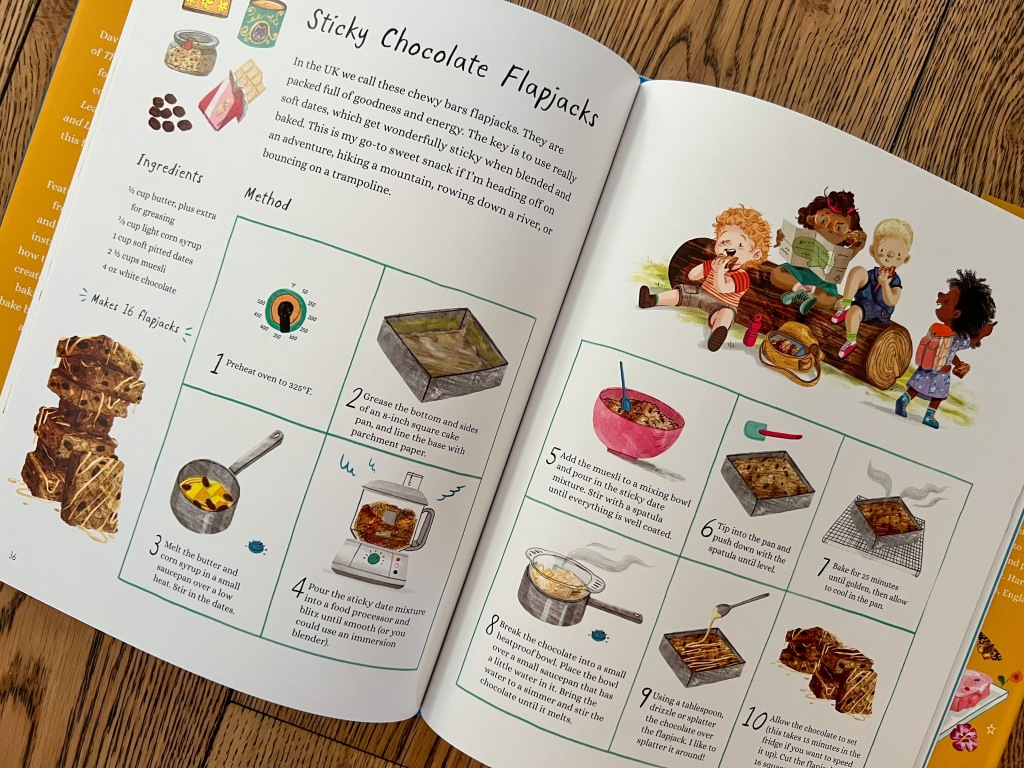
Parents will appreciate that the book also covers hot-oven tips, as well as notes on the science of baking. They’ll also appreciate being on the receiving end of their newly-crowned baker’s creations.
For the Eric Carle Graduate
What’s Inside a Caterpillar Cocoon? And Other Questions About Moths and Butterflies
by Rachel Ignotofsky
Ages 7-10
I don’t know who needs to hear this, but Eric Carle had it wrong: butterflies emerge from chrysalises; it’s moths that hatch from cocoons! We’ve come a long way since 1969, and lots of butterfly-themed picture books with which to course correct, but we have hit the jackpot with this one. What’s Inside a Caterpillar Cocoon? And Other Questions About Moths and Butterflies is hands down the most gorgeous scientific presentation of butterfly vs. moth that I’ve ever seen.
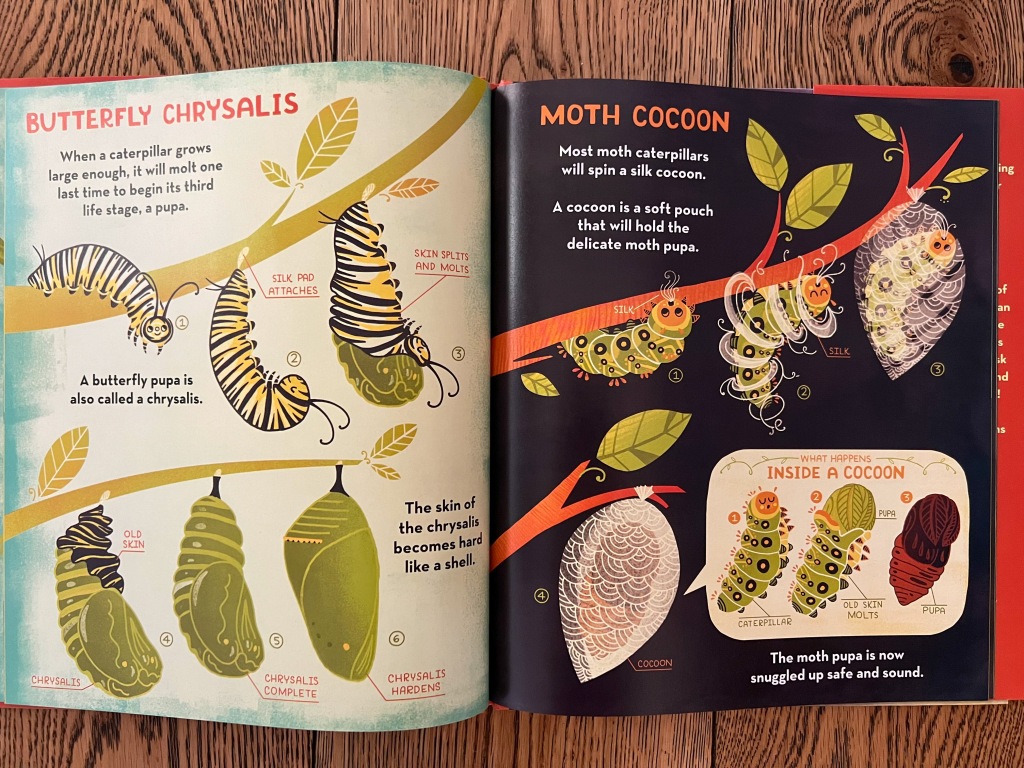
Presented alongside jaw-dropping illustrations is an impressive amount of information about the life cycles of butterflies and moths, their similarities and differences. And yet, we never feel bogged down in scientific minutiae! The text is presented cleanly, engagingly, and conversationally, and it never detracts from the arresting visuals. And lest you think you’ve heard all this science before, allow me to list a few of the things I learned. Some moths drink using their tongues (like butterflies), some chew up plants, and some eat nothing. Butterflies who can’t get the minerals and salt they need exclusively from flowers will resort to drinking from muddy puddles in something called “mud-puddling.” And both butterflies and moths have teeny tiny scales covering their wings and bodies, without which they would be completely see-through.
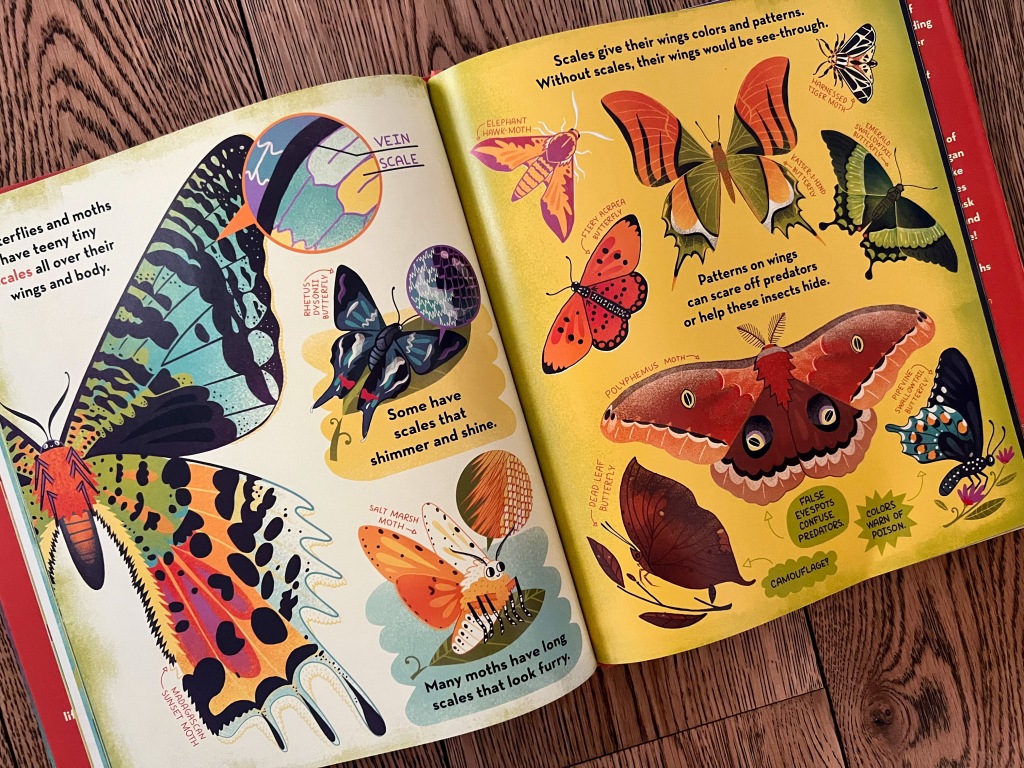
What is perhaps most striking upon paging through this book is the spectacular diversity within and across the butterfly and moth populations, including their respective chrysalises and cocoons. If you ever want a reminder of the extraordinary artistic skills of Mother Nature, look no further!
For the Animal Lover
The Wonder Garden: Wander Through Five Habitats to Discover 80 Amazing Animals
by Jenny Broom; illus. Kristjana S. Williams
Ages 7-10
Non-fiction books about animals are a dime a dozen. What makes this one stand out, apart from its large trim size, is its striking gold and neon art. The Wonder Garden is a feast for the eyes, a striking ode to the biodiversity that makes our planet so magical. (Some of you might recall that Jenny Broom is the author of Animalium, a book we can trace all the way back to the 2014 Gift Guide!)
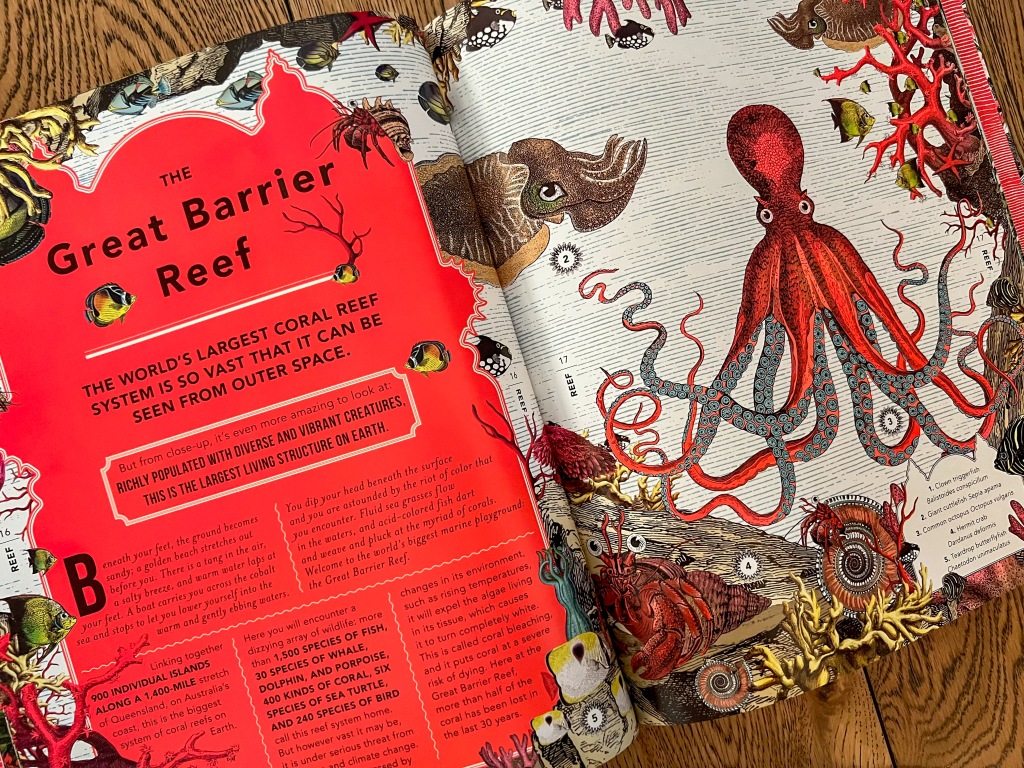
Organized by habitat, our journey covers the Amazon’s hot, humid rain forests, with its colorful birds and reptiles; the Great Barrier Reef with its teeming shoals of fish; the Chihuahuan Desert, which straddles the border between America and Mexico and is one of the toughest places for animals to survive; the fairy tale woodland of the Black Forest in southwestern Germany; and finally, the Himalayas, the so-called “roof of the world,” whose winds burn our cheeks and numb our fingers as we take in the animals of the foothills and higher ground.
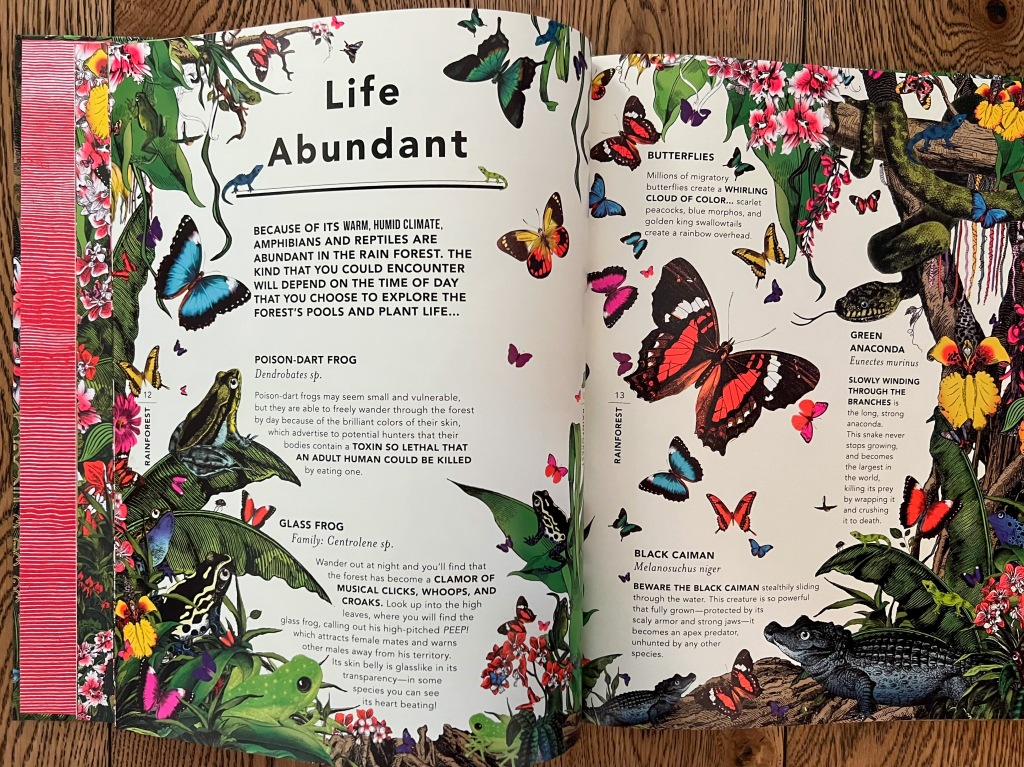
Rendered to recall the tableaux of natural history museums, the animals pop against finely-detailed backdrops infused with a storybook quality. Eye candy, I tell you. Every. single. page.
For the Survivalist
Pirate Peril: Spin to Survive
by Emily Hawkins & R. Fresson
Ages 8-12
This is another series that needs no introduction for most of you. When I mentioned on social media that I was working on this year’s Gift Guide, quite a few of you messaged me to ask if there would be a new title in this series, with its interactive twist on the choose-your-own adventure trope, pitting survival skills against the treacherous tides of chance. It’s giant, it’s meaty, it comes with a toy, it’s hours of fun: this one has gift written all over it.
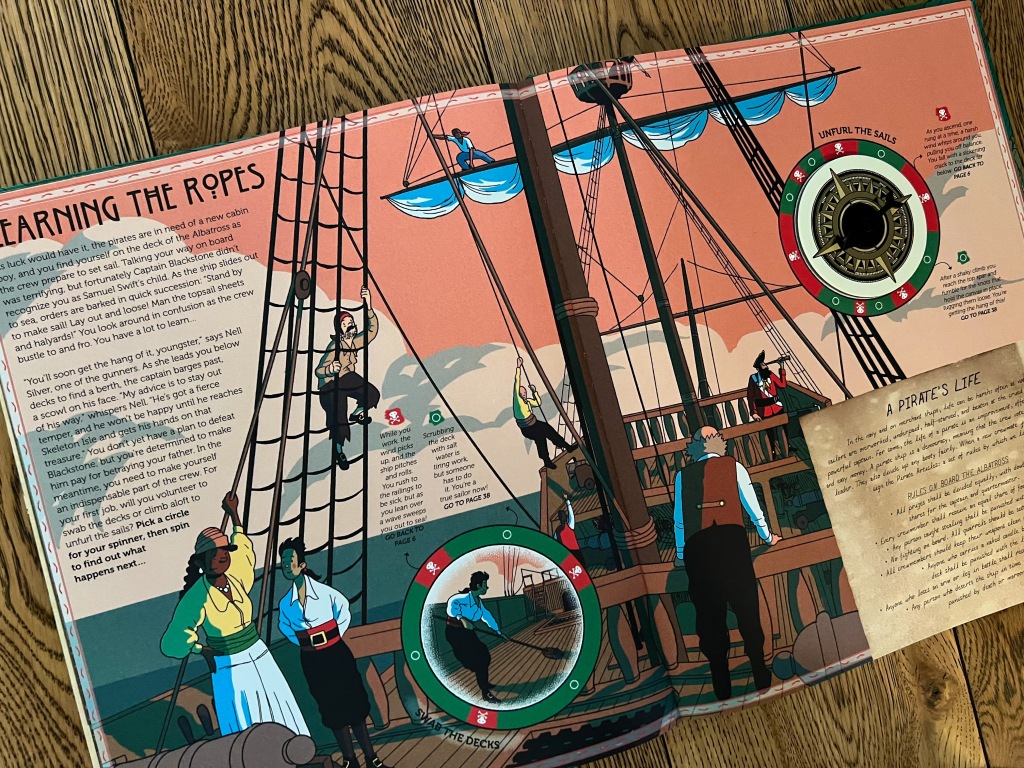
Get ready for swashbuckling scoundrels and mutinous marauders, because this year’s Spin to Survive theme is Pirate Peril! Our father, the good-hearted pirate Captain Samuel Swift, has entrusted us with his cutlass and the tattered map leading to his buried treasure. But this is the Caribbean in the 18th century, which means danger looms on the horizon, perhaps even on board our own ship. Will we head out to search for the treasure, sign on with a crew of pirate-hunters, or embark on the riskiest course of all: joining forces with the pirates who betrayed our father? Only the Survival Spinner (included) can make the choice…
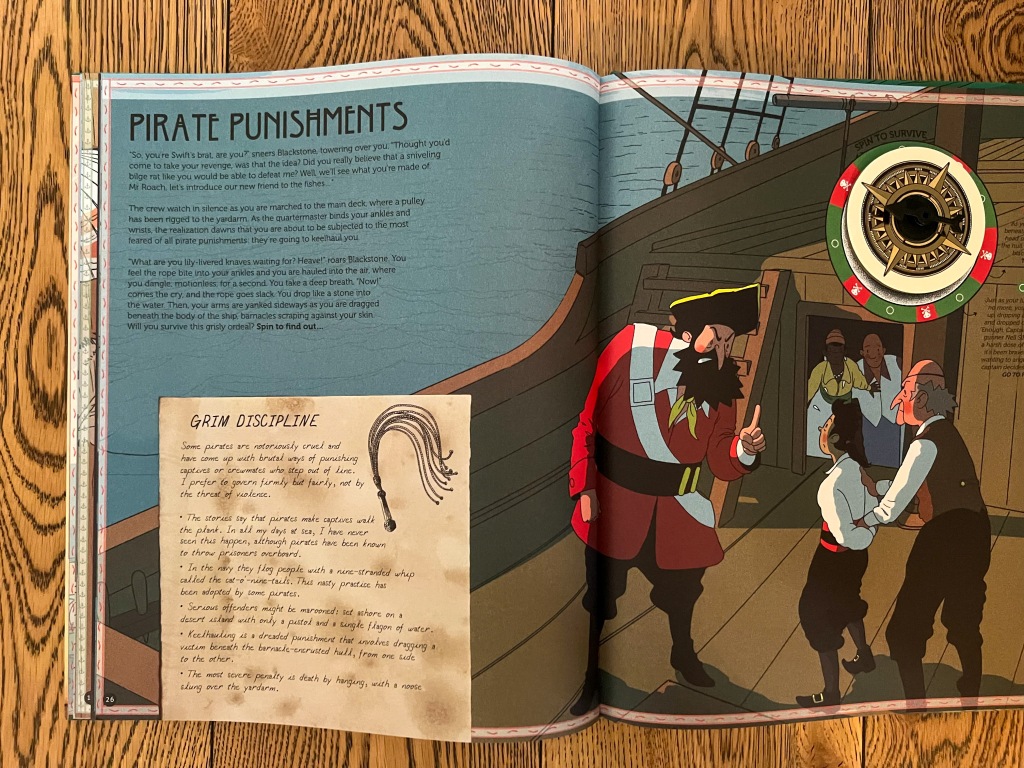
As we play through different adventures, we might encounter certain death, fame and fortune, or any number of unexpected surprises. But one thing’s for sure: along the way, we will discover historical facts about 18th century pirating, as well as tips for surviving the many dangers of the sea, including hurricanes, sharks, cannon-fire, and cut-throats!
For the Optimist
Return of the Wild: 20 of Nature’s Greatest Success Stories
by Dr. Helen Scales; illus. Good Wives & Warriors
Ages 8-12
With a look at twenty environmental success stories, Return of the Wild reads like a breath of fresh air. Positive change is possible! At a time when we want to get the future stewards of our planet to care about the increasingly dire effects of climate change, perhaps we would do better to focus on ways that nature has come back from the brink with advocacy and hard work, as opposed to the doomsday tone taken by so many.
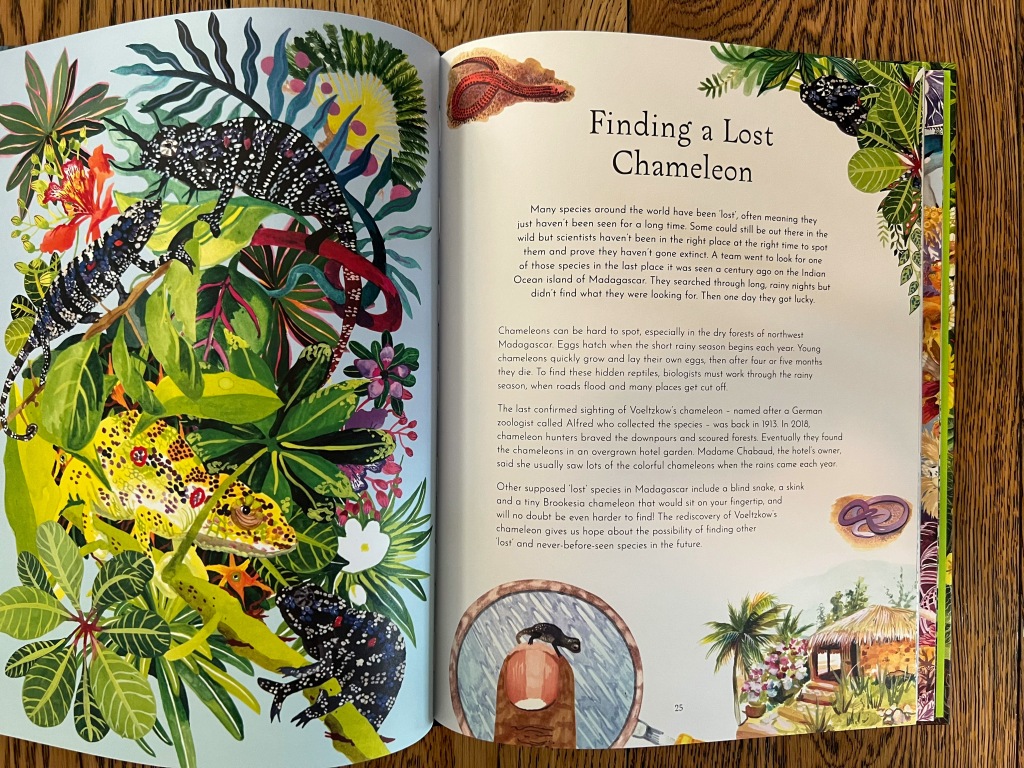
Humpback whale populations thriving once again in the freezing seas of Alaska…the recovery of kiwi populations in New Zealand…the setting up of tiger sanctuaries and reserves in India…the return of elephant seals from extinction. These are just a few of the incredible stories profiled, one per page, opposite a vibrant full-color illustration.
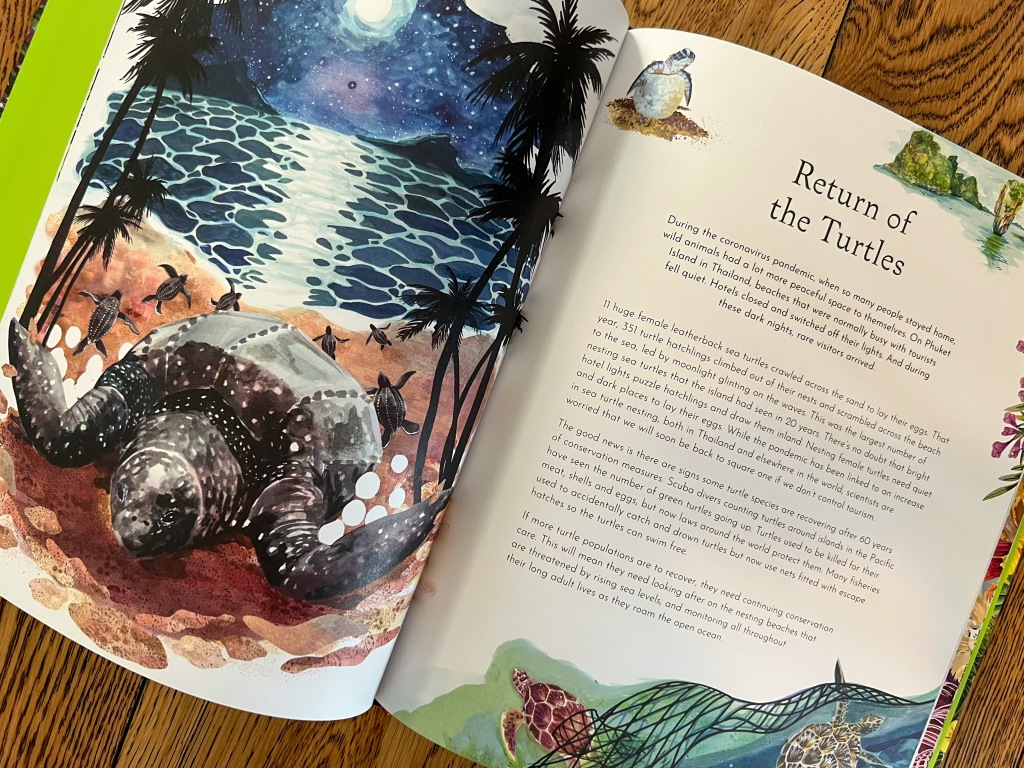
The extensive backmatter teaches children about the different habitats that animals and plants around the world call home—oceans, forests, deserts, wetlands, and more—and introduces them to some of the real people supporting endangered species. Tips are offered on what children at home can do to help the wild world, from wearing eco-friendly sunscreen while swimming in the sea to using less single-use plastic.
For the Mythology Buff
Greeking Out: Epic Retellings of Classic Greek Myths
by Kenny Curtis & Jillian Hughes; illus. J. Espila
Ages 8-12
Despite the fact that its intro song gets stuck in my head every single time, National Geographic’s Greeking Out podcast remains a favorite in our house. Greek Mythology has never been so fun—or funny. Now, in the book of the same name, these folks have delivered clever tongue-in-cheek re-tellings of twenty classic Greek myths, some taken straight from the podcast and others new to listeners.
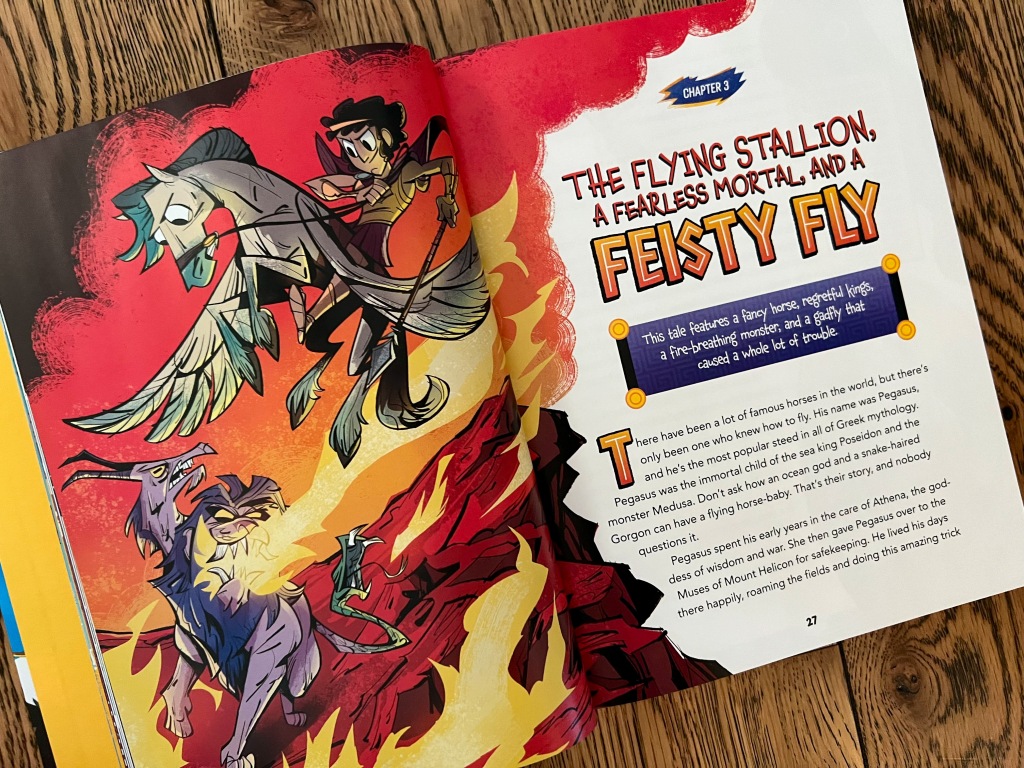
Join Persephone on her journey through the mystifying depths of the Underworld. Venture alongside Heracles as he tackles his twelve death-defying labors. Join mythological figures you may not have heard of before, including scheming gods and goddesses, honorable—and not so honorable—heroes, and magnificent monsters. Don’t worry, everyone’s favorite from the podcast, the all-knowing Oracle of Wi-Fi, makes frequent appearances to keep us straight on our Ancient Greece history.
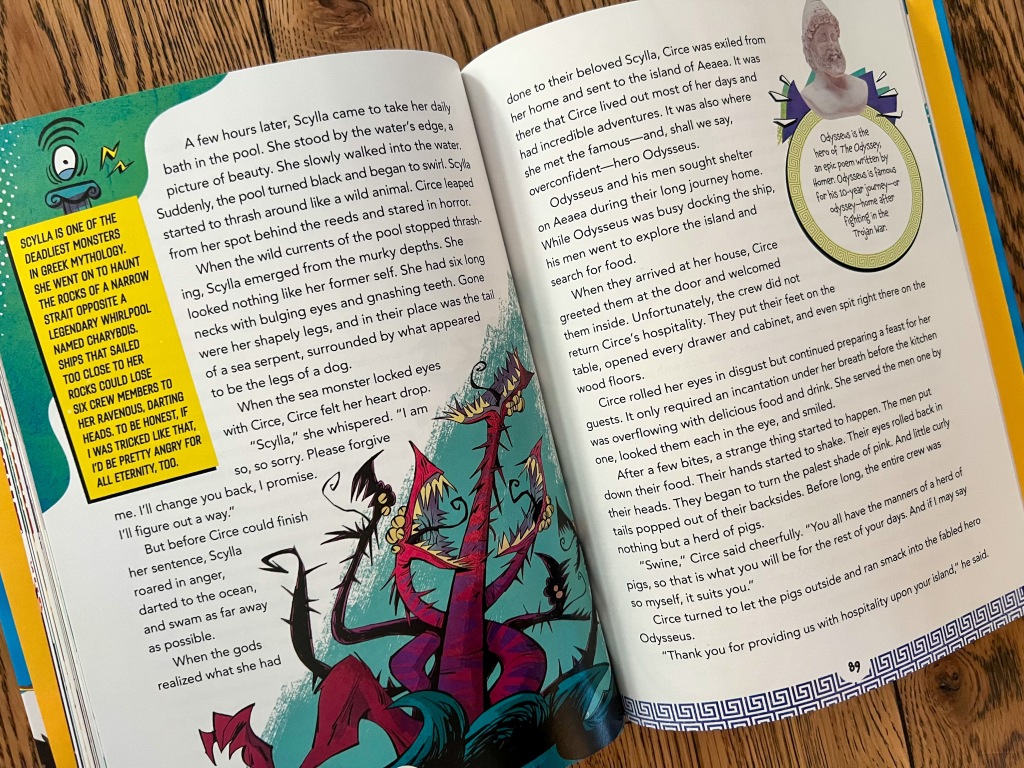
With 185 pages jam-packed with text and full-color artwork, this book gets terrific bang for the buck, a true mythology lover’s dream. And with the new Percy Jackson series coming to Netflix this winter, there has never been a better time to brush up on our mythology.
For the Future Grown-Up
What About: Digital Tech?
by Romain Gallissot & Baptiste Massa; illus. Pascal Lemaître
Ages 8-12
You might remember that last year’s Guide featured another title from this Q&A series, with actual questions from real kids. That one was space-themed. This fall, we have one that should prove especially useful for today’s kiddos: What About: Digital Tech?, tackling the history, present, and future of life online. For this review, it seemed only fitting to draft my husband, a professional in the cybersecurity space, to chime in. Here’s what he had to say:

“Presented in bite-sized chapters, I really liked the vignettes chosen to illustrate so much complexity in a way that kids can understand. What is the “cloud”? What’s involved in making video games? How is it that my phone knows exactly what I want to buy before I do? Short, digestible topics help make things clear in ways that digitally native kids (and digitally naive grandparents!) can understand. The book also delves into other important aspects of Digital Technology: the energy footprint of all that computing power, proper and healthy online behavior, and even a bit on cybersecurity. (This is my one complaint: the book’s authors hold up the hacker collective Anonymous as heroes of the internet, where most cyber defenders would disagree.)
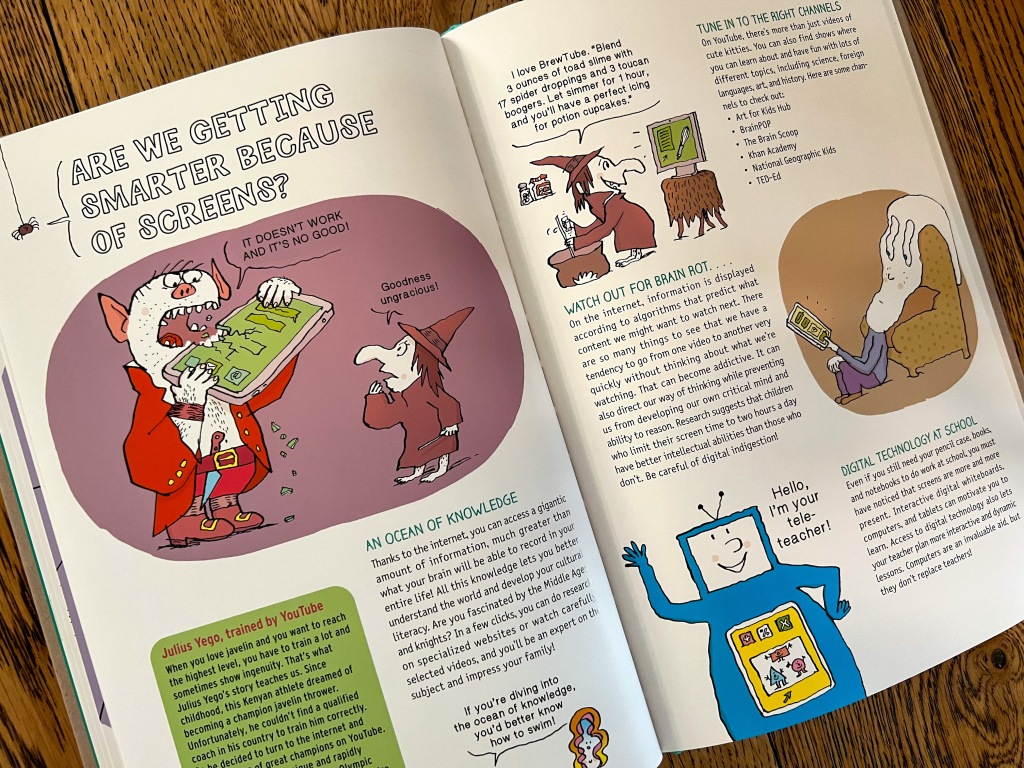
The illustrations are adorable as well, bringing the straight-forward prose to life with a bit of whimsy that helps you forget you’re reading about technology. Even the most screen-obsessed kid will find something in here to answer a question they always had. Who knows, maybe they’ll even pick up some healthy digital habits in the process!”
For the Engineer
Transported: 50 Vehicles That Changed the World
by Matt Ralphs; illus. Rui Ricardo
Ages 8-12
Transported: 50 Vehicles That Changed the World is as impressive as any adult coffee table book, and if my husband and teen son’s enthusiasm is any indication, it will have legs well beyond its intended audience. It’s a fascinating journey from past to present—down highways, over rails, under oceans, and above clouds—to discover the vehicles that changed the course of history and helped shape the world we live in.
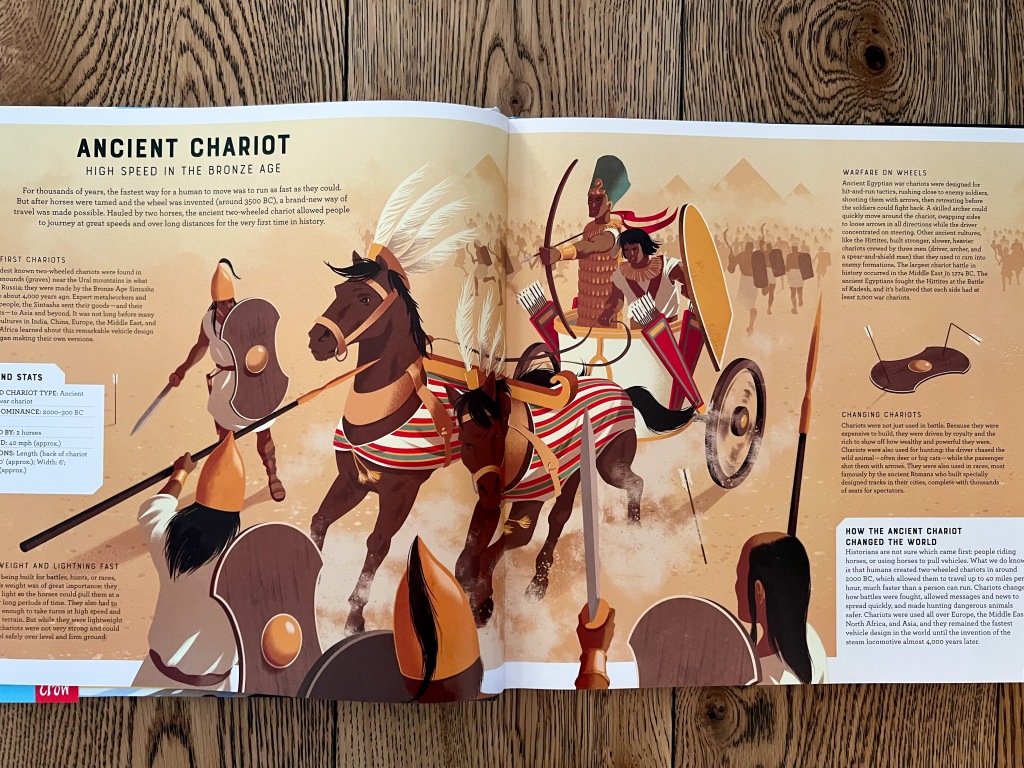
Where would we be without inventions around transportation? The ancient chariot, Viking longship, hot air balloon, steam locomotive, fire engine, ocean liner, aircraft carrier, snowmobile, auto rickshaw, Saturn V rocket, spy plane, Concorde, Mars rover, and electric bike are just some of the vehicles profiled across gorgeously illustrated double-page spreads. For each, we get Facts & Stats, as well as paragraphs about how the vehicle worked, why it was significant, and the way it changed the world.
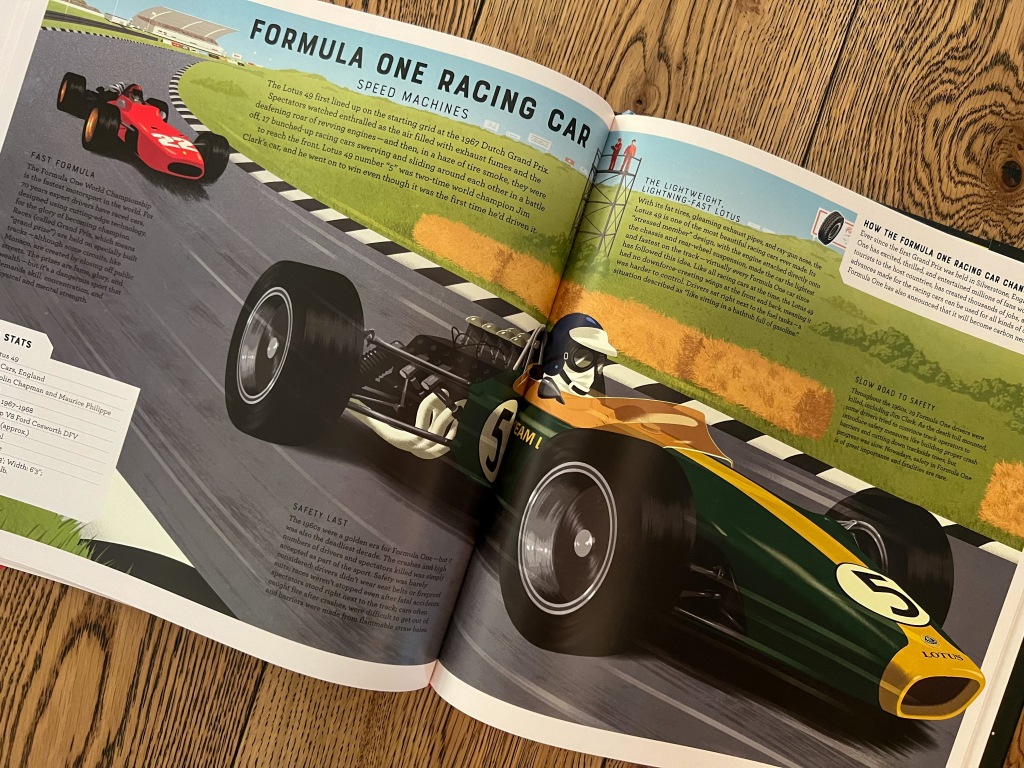
The book doesn’t shy away from technical details, like engine design, either, making this the perfect gift for the kid who once had you reading Richard Scarry’s Cars and Trucks and Things That Go before the sun was up every dang morning. (I wasn’t alone, right?)
For the Historian
Tales of World War II: Amazing True Stories From the War That Shook the World
by Dr. Hattie Hearn; illus. Margarida Esteves
Ages 8-12
Like many elementary kids, my son used to beg me for books about World War II. And I get the concern parents have about this obsession, worried their child is either glorifying the violence inflicted by those shiny bombers or exposing themselves to disturbing images. Actually, there are many age-appropriate books that delicately handle this vast and complex topic, and my new favorite is Tales of World War II, a collection of incredible true stories of espionage, resourcefulness, and bravery, penned by a WW2 historian.
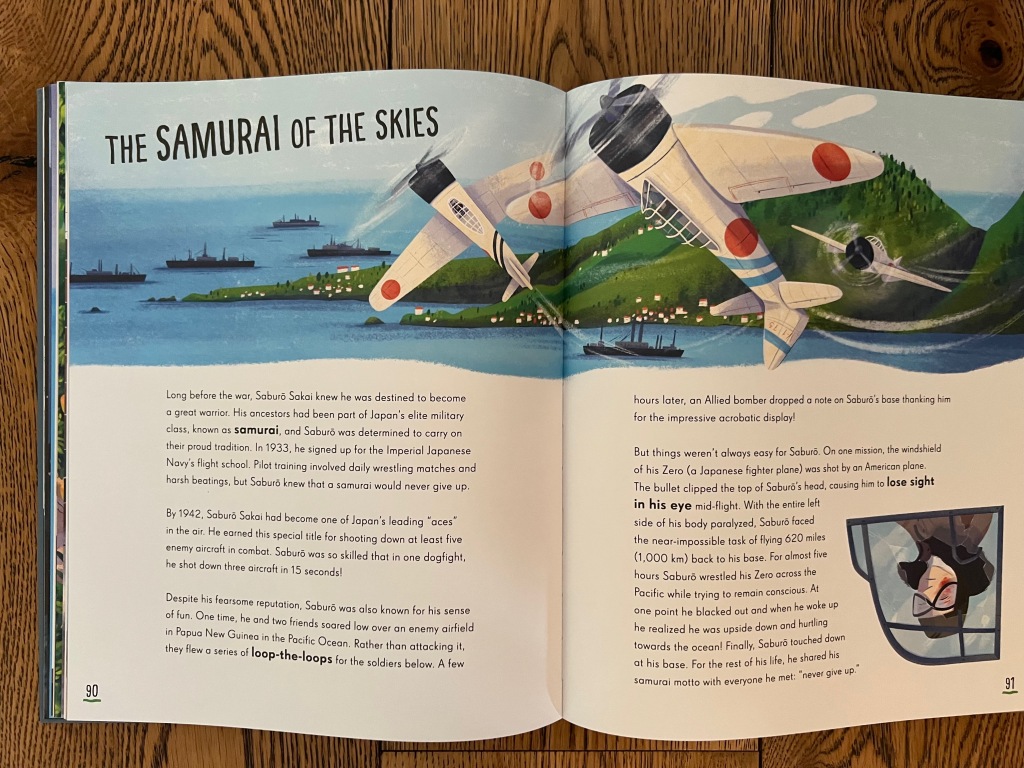
The 68 stories chronicled here, each across one or two pages and complemented by full-color artwork, are impressively diverse, highlighting daring pilots, heroic nurses, brave evacuees, and even amazing animals. There is a story about an African-American jazz singer who worked as a spy; the dog used to find survivors in the London Blitz; the champion cyclist who carried secret messages to help Jews escape the Nazis; and the bear who was recruited by the Polish army and given the rank of private. Ever heard of the Night Witches? A Tiger tank? Now you will.
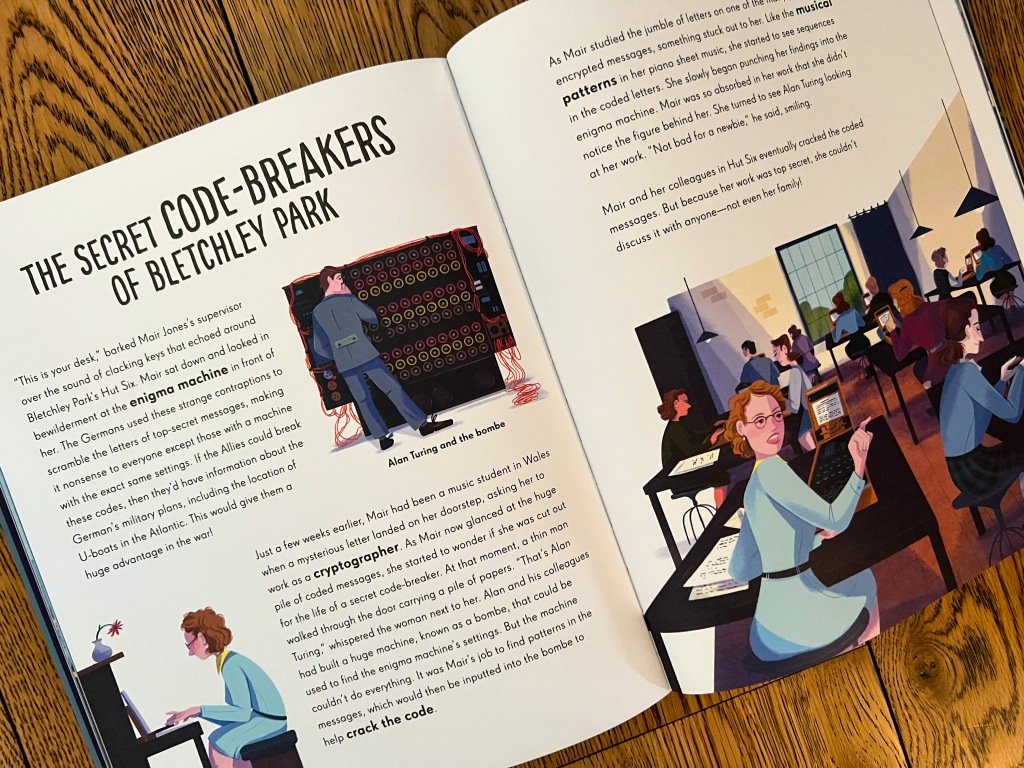
Many of the stories center the children who demonstrated remarkable courage in the face of extraordinary circumstances. With so many reminders of WW2 around us today, this history continues to be important for our children to understand, and this presentation should be especially compelling.
For the Foodie
Pizza, Pickles, and Apple Pie: The Stories Behind the Foods We Love
by David Rickett
Ages 8-12
Mere hours after I had finalized the picks on this installment, an early finished copy of Pizza, Pickles, and Apple Pie: The Stories Behind the Foods We Love showed up on my doorstop. My husband got his hands on it, and from his hoots and hollers, gasps and soundbites, it quickly became clear that I was going to need to squeeze in one more.
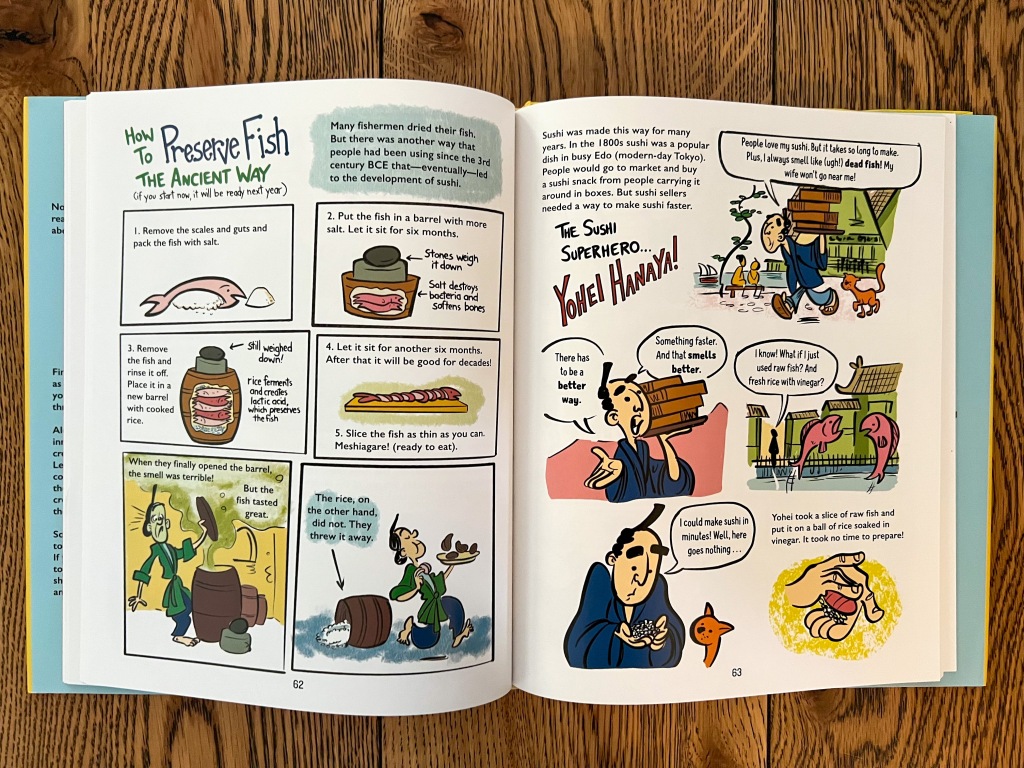
Employing full-color comics and a conversational tone—right there you’ve hooked young readers—the book explores the evolution of a myriad of favorite foods and mealtime practices. Did you know it was once believed that eating breakfast was dangerous? Did you know cereal was invented to make people poop? That yogurt produces a party in your gut? That a pizza was once delivered to the International Space Station for one million dollars? That in Japan people celebrate Christmas by ordering fried chicken takeout? That candles on cakes date back to the Ancient Greeks? That a floating ice-cream parlor was made during WW2 to service the US Navy?
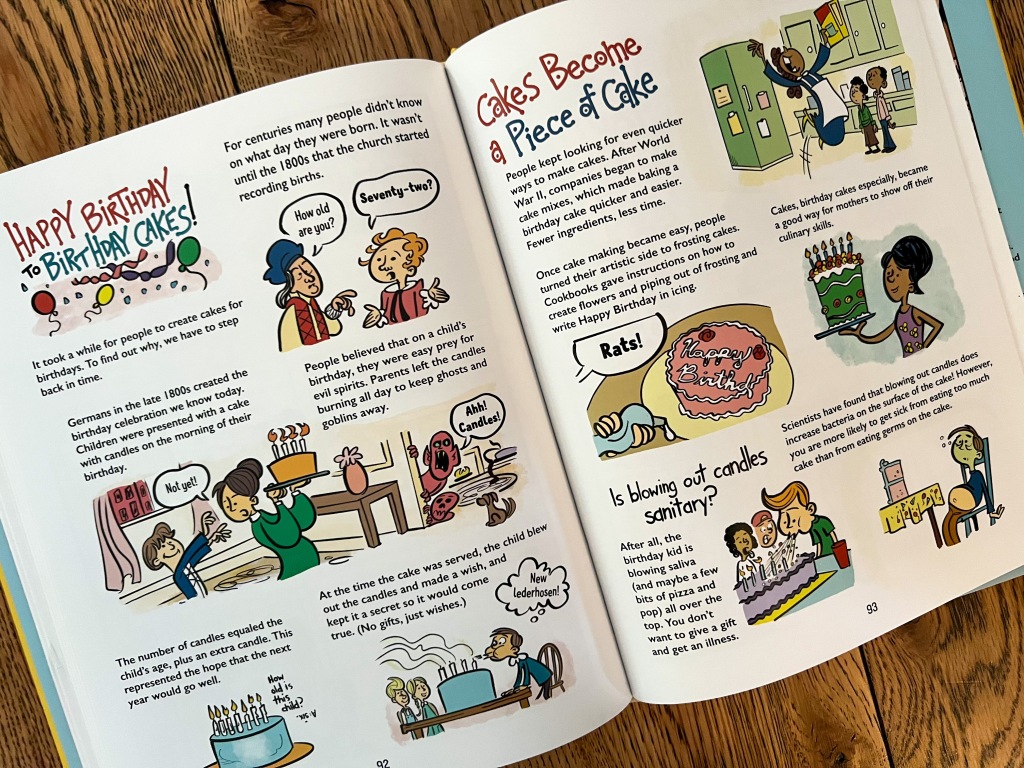
Woven throughout is the impact of class, technology, and geography on the way we eat, with a particular spotlight on America’s history with colonialism, slavery, and segregation. With any luck, kids won’t even realize they’re getting schooled on nutrition (the age-old protein vs sugar debate). And there are fun bonuses, like recipes and a tutorial on making your own food comic. All in all, a fantastically engaging book to kick off this Season of Eating.
For the Budding Adolescent
Growing Up Powerful: A Guide to Keeping Confident When Your Body is Changing, Your Mind is Racing, and the World is…Complicated
by Nona Willis Aronowitz; illus. Cathy Marquina
Ages 8-12
Until now, my Gold Standard for “puberty on the horizon” books have been Robie H. Harris and Michael Emberley’s It’s So Amazing and It’s Perfectly Normal (the second is still the best for conversations about sexual health). But, for girls, I also really, really like this new title by Rebel Girls, created to address the fact that between the ages of 8 and 14, girls experience a major drop in confidence. Through the lens of empowerment, Growing Up Powerful tackles the usual suspects of pimples, periods, consent, and gender/sexual identity, while also devoting attention to anxiety, friendship drama, peer pressure, overwhelming news headlines, and much more.
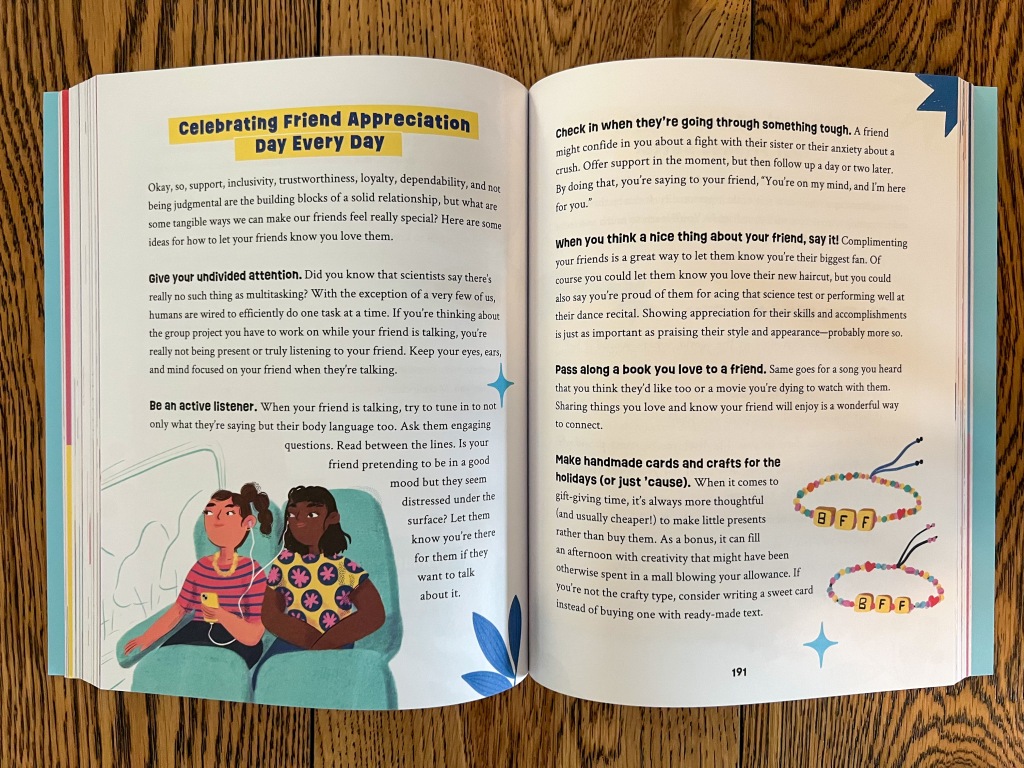
Each chapter begins with an affirmation and follows with advice on different topics, Q&As between experts and girls around the world, and fun quizzes. In “My Brain is Powerful,” for instance, readers learn how their minds process information, so they can stay healthy and positive as they experience worries and mood swings. “I Can Create Community” explores the ins and outs of creating connections and making friends, even when it’s nerve-wracking. How do you tell the difference between a good risk and a bad risk? How do diet and exercise influence mood? How do you keep yourself safe online? How do you know when you’re ready to date?
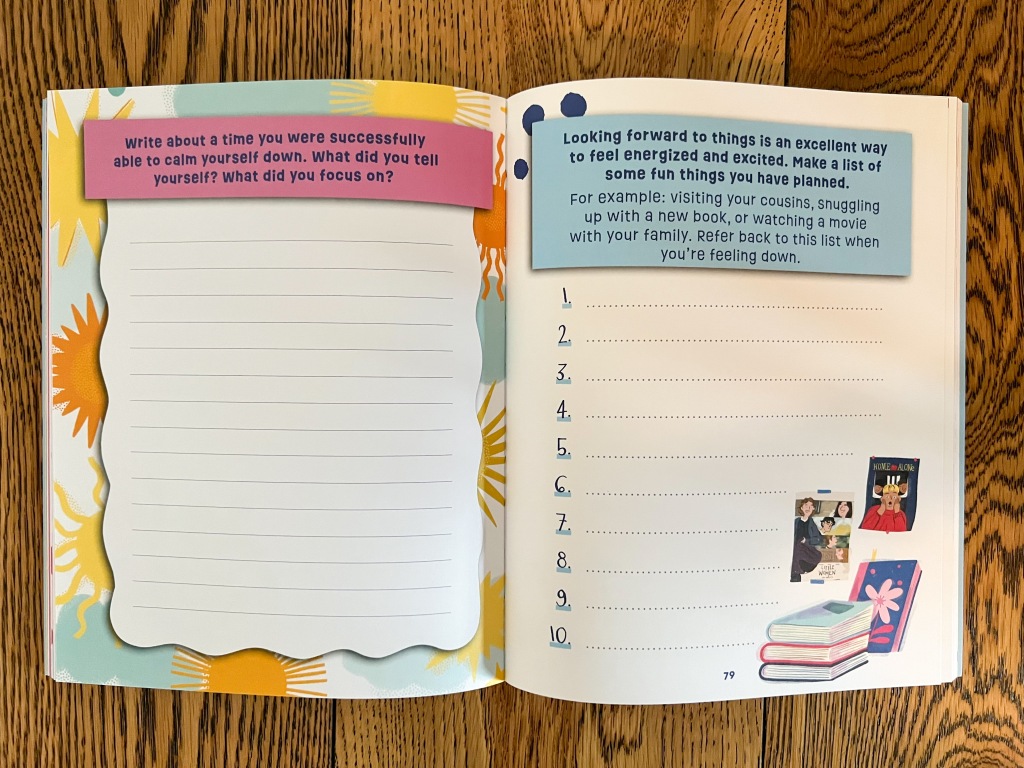
To go along with the book, you might also want to get the Growing Up Powerful Journal (excerpt pictured above), with questions, activities, and writing prompts based on the book!
For the Visual Learner
Britannica’s Encyclopedia Infographica: 1,000s of Facts & Figures Revealed Through Pictures
infographics by Valentina D’Efilippo; written by Andrew Pettie & Conrad Quilty-Harper
Ages 10-15
Visual literacy is quickly becoming one of the most essential skills of today. Did you know 70 percent of the way our brain perceives the world is visual? (Another reason not to discourage tweens and teens from reading graphic novels, wink wink.) This new encyclopedia from Britannica, with infographics by internationally renowned data designer Valentina D’Efilippo, lets pictures do the talking to impart astonishing information about space, Earth, animals, humans, and technology.

Employing 200 infographics, including maps, charts, timelines, and more, the book is organized into six sections: Space; Land, Sea, Sky; Living Planet; Animals, Human Body; and Human World. Grasp facts at a glance with every page: discover the size of our Sun in comparison to the largest star in the universe; find out which animal can leap 200 times its body length; learn how many cups of snot your body makes a day; compare the sizes of the biggest beasts that have ever lived; or witness what happens in a single second across the world.
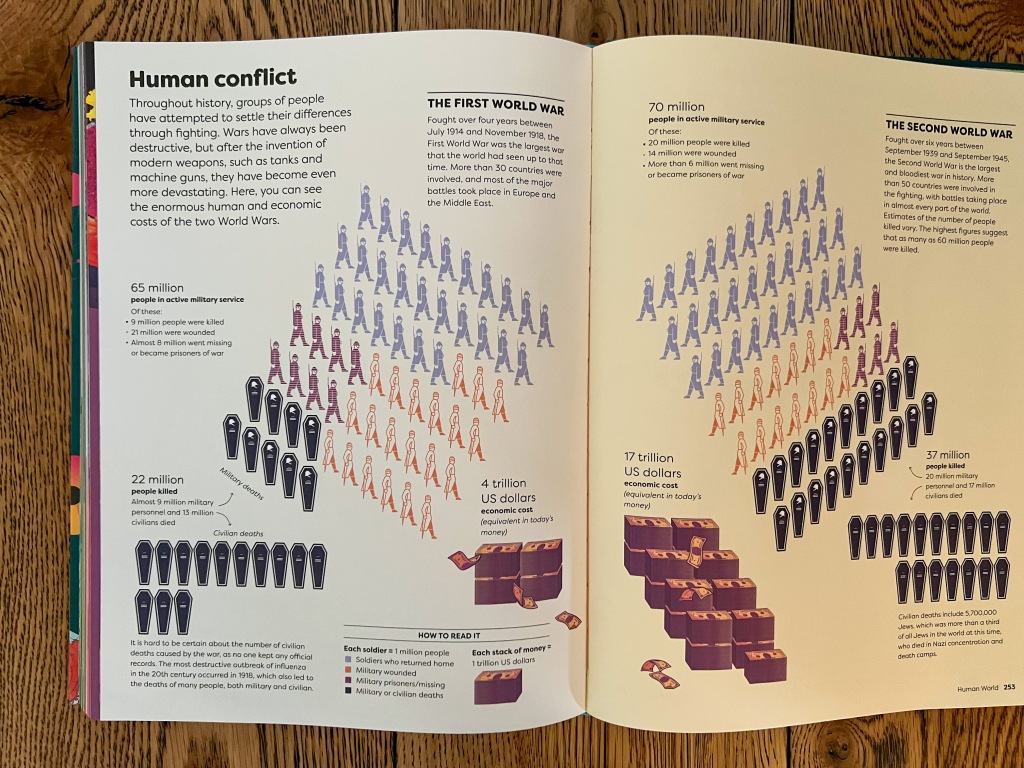
An exhilarating visual way to understand the world around us, Encyclopedia Infographica feels like a slam-dunk Boredom Buster.
For the Backyard Scientist
What It’s Like to Be a Bird (Adapted for Young Readers): From Flying to Nesting, Eating to Singing—What Birds are Doing and Why
by David Allen Sibley
Ages 10-adult
When I got my hands on this gorgeous and accessible young reader’s adaptation of David Allen Sibley’s bestselling adult book, I joked that I was going to put it on the Gift Guide for grandmothers to buy in a futile attempt to get their grandkids to join them in obsessing about birds. (Speaking from failed years of trying to get my own kids excited about such things.) Then, a month ago, my daughter embarked on a mandatory bird unit in science class. Two weeks in, she came home to tell me she “might be becoming one of those crazy birder people,” and my heart skipped a beat. Because birds are amazing! And with my faith in young people now restored, I’m going to proclaim that if there was ever a book destined to make a birder out of us, it’s What It’s Like to Be a Bird.
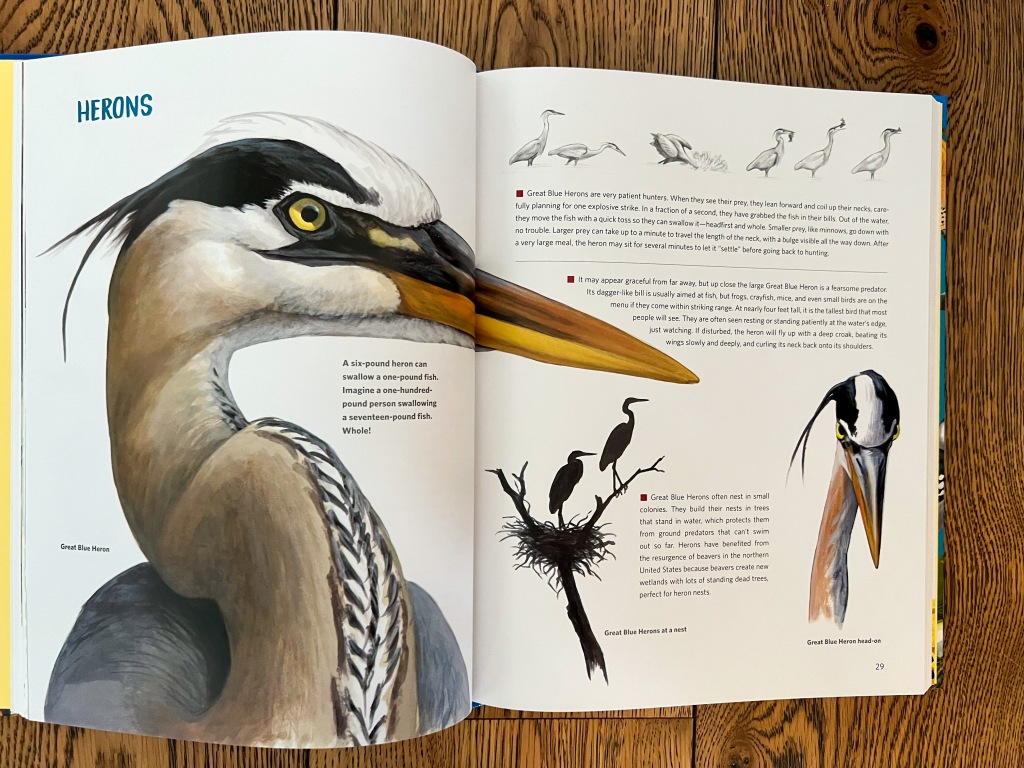
Inside 170 pages, readers will be introduced to the science of birds, including a treasure trove of fascinating facts, paired with more than 300 full-color illustrations, many life-size. While the first part of the book is an overview of bird physiology, food habits, survival adaptations, reproduction, and the essential role birds play in our ecosystem, the heart of the book likes in the robust second part: a portfolio of the most common and/or familiar birds in the continental United States and Canada. That artwork!
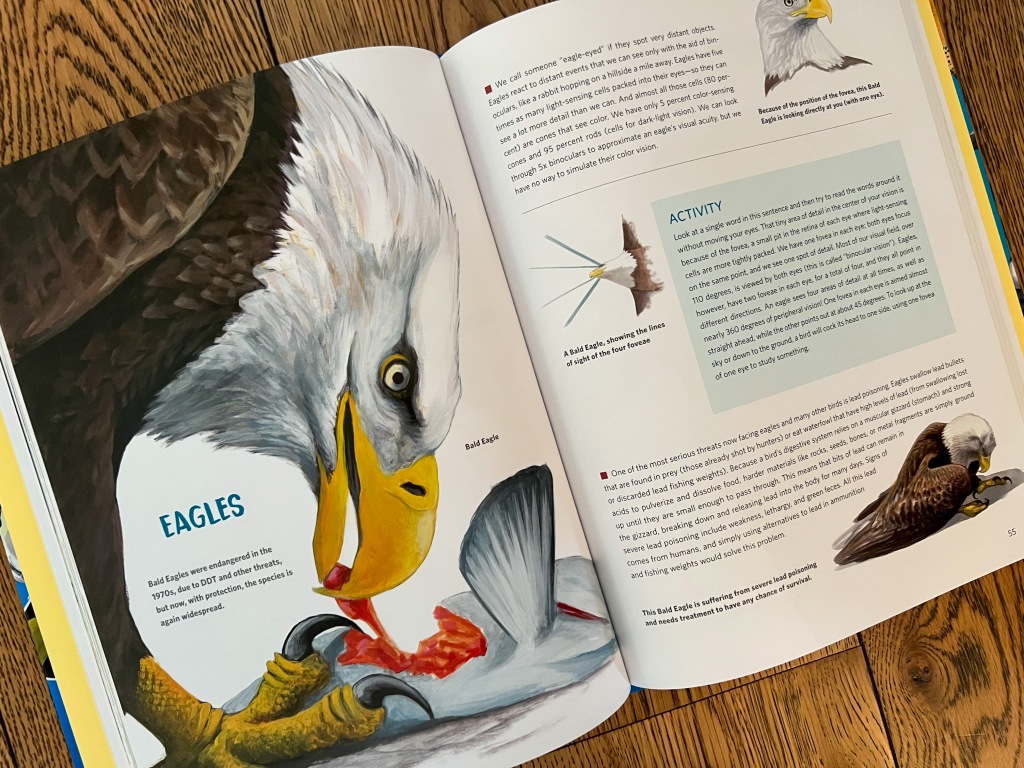
Did you know many species of birds have sensory abilities that surpass those of humans? Or that some birds spend the entire winter in the air and even sleep while flying? These are just some of the questions answered by this book, which allows us to see the world through the eyes of the feathered friends right outside our front door.
Have you enjoyed this post? Make sure you don’t miss others! Enter your email on the right hand side of my homepage, and you’ll receive a new post in your inbox 2-4 times a month. Plus, follow me on Instagram (@thebookmommy), where I’m active most days, posting reviews and updates on what my kids are reading, or Facebook (What To Read To Your Kids) and Twitter (@thebookmommy).
All opinions are my own. Links support the beautiful Old Town Books, where I am the children’s buyer (and yes, we ship!).
